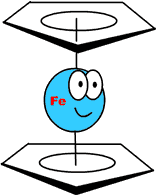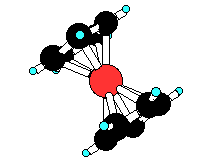 TEL was developed as a fuel additive in the early 1920:s by one
Thomas
Midgley, jr. The very same person later developed FREON for refrigerators.
An Antichrist to the environmentally concerned!
TEL was developed as a fuel additive in the early 1920:s by one
Thomas
Midgley, jr. The very same person later developed FREON for refrigerators.
An Antichrist to the environmentally concerned!
[ white: hydrogen; blue: carbon; green: iron ]


|
A TEAM RACING FUEL DEVELOPMENT |
[We're dealing with model racing airplanes. (In case a search engine brought you here.)]
Check my Control Line Page
A replacement for TEL (tetraethyl lead) has been found which is considerably less toxic and offers improved running characteristics.
Team racing fuels have remained remarkably constant over the years while engines, models, propellers and so on have been taken to performance levels never imagined. Oil reduction is the most striking change to the fuel.
The base formula for a T/R diesel fuel of today is:
| Kerosene (aka Paraffin, Petrol) | 50 - 55 % |
| Diethyl Ether | 32 - 40 % |
| Castor Oil (or in part synthetic oil) | 8 - 12 % |
| Some sort of Alkyl Nitrate,
like Amyl Nitrate, often branded "Diesel Ignition Improver" | 1.1 - 2.5 % |
| Some kind of detergent, like Lubrizol ADX511C (formerly 52) | ~.1 % |
(Take the middle values and you have a good point to start from. 1/3 of the castor oil could be replaced by a good synthetic oil. You may have to experiment with the nitrate content to adjust to the engine, prop and the grade of kerosene you have. The amount of Lubrizol should also be adjusted to the kerosene grade to keep piston deposits acceptable.)
In this decade also the practice of adding TEL to the fuel has become widely adopted. The content is normally .6 - .8 milliliters of "Ethyl Fluid" (containing also other substances) per liter of fuel. This allows clean running at a higher compression setting, giving an improvement in efficiency and power.
This was a Soviet secret for some time, but became known to the outside world around 1990. TEL, with chemical formula Pb(C2H5)4, is the compound also used as an octane number improver (anti-knock) in petrol (gasoline) for spark plug engines, until catalyzers and environmental concerns have led to its phasing out. The use here is surprising at a first glance, since octane no. of a diesel fuel is something normally not called for.
Octane no. indicates the resistance to ignite under compression for a spark plug fuel. For a diesel fuel, in contrast, cetane no. is used to indicate the willingness to ignite under compression. Alkyl nitrates are used as cetane improvers.
TEL is extremely toxic and hazardous to use, since it contains lead in a form that is readily absorbed by the body through inhalation and absorption through the skin. It is therefore totally restricted in most countries, and the T/R community has resorted to sources from the former Soviet Union.
The hazard from exposure to the finished fuel is probably small, but it is considerable when handling the concentrated TEL. Therefore the TEL use has been under debate, and its ban has been suggested. The means of enforcing this ban by a useful field test have not been found, however. Even the resort to a standard fuel in T/R has been discussed. Such a thing would to my mind severely cripple T/R.
Fortunately, the use of TEL for cars has been under scrutiny for much the same reasons for at least 40 years, and an intense search for replacements has been undertaken. From studying this knowledge database, and testing various substances, I have found one that, while not useful for cars, has proven to be an excellent replacement for TEL in T/R.
The compound is ferrocene, (dicyclopentadienyl iron), Fe(C5H5)2, or Fc for short.
This is an amber crystalline substance that dissolves easily in ether, and to a lesser extent in kerosene. It is essentially non-toxic. (The label caution text says "Harmful if swallowed", which indicates that it is no more harmful than any other T/R fuel component.) I have used it in my T/R fuel since the spring of 1995, at a concentration of .8 grams per liter. In 2002 I have used .5 grams per liter.
(I learned in September 1997 that the German team of Marschall/Kuckelkorn tried ferrocene already in 1990.)
The action is similar to TEL, in that a higher compression setting is possible, giving a performance increase. The only drawback I have found is an increase in deposits on the piston top. (Probably a ferric oxide/soot mixture.) This is not a big problem, since the engine should be cleaned thoroughly after each use for other reasons. My impression is that the running characteristics are improved compared to TEL. The take-off acceleration is better, indicating a broader RPM range. I am most interested to hear what others with no own-child bias will find.
It is interesting to note that the fuel will contain two substances that essentially counteract each other:
| Cetane No. | Octane No. | Compression | |
| Alkyl Nitrate: | + | - | - |
| TEL or Fc: | - | + | + |
Just reducing the nitrate will also lead to a higher compression setting, but no increase in power, and no clean running at high RPM. My speculation is that lowering the nitrate will reduce the combustion speed, and that the combination with TEL or Fc means that the ignition can be delayed (for a higher compression setting) while the combustion speed is kept.
Ferrocene is available through chemical retailers. Sigma/Aldrich sell 25
and 100 gram jars, and Merck sells 50 gram jars. A 50 gram jar is around
US$60. (When the astronomical handling charge is paid.)
I have no more ferrocene to sell. (November 2003)
You can check with Lionel Smith of South Africa, who told me he has ferrocene for sale. (September 2000)
I have found it convenient to dissolve 5 grams of Fc in 500 milliliters of kerosene and then replace 5-8% of the kerosene in the fuel with this solution. (Unless you have a milligram scale.)
A few curious asides:
 TEL was developed as a fuel additive in the early 1920:s by one
Thomas
Midgley, jr. The very same person later developed FREON for refrigerators.
An Antichrist to the environmentally concerned!
TEL was developed as a fuel additive in the early 1920:s by one
Thomas
Midgley, jr. The very same person later developed FREON for refrigerators.
An Antichrist to the environmentally concerned!